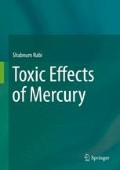Abstract
Selenium (Se) acts as an antagonist to the toxic effects of many heavy metals, including mercury (Yoneda and Suzuki 1997; Falnoga and Tusek-Znidaric 2007). This essential trace element (Combs and Combo 1984) is important in many biological functions, since it is a cofactor in selenium-containing enzymes, especially in antioxidant enzymes such as glutathione peroxidase (GSH-Px) (Rotruck et al. 1973). This enzyme is effective in catalyzing the decomposition of hydrogen peroxides and lipid peroxides. When GSH-Px activity is inhibited, peroxides formed during oxidative stress can propagate cell damage. Measurement of this enzyme activity is an indirect and noninvasive method that could be used to assess oxidant stress. The activity of this enzyme has been used to assess body selenium status and nutritional requirements (Levander 1991).
Access this chapter
Tax calculation will be finalised at checkout
Purchases are for personal use only
References
Anderson HR, Anderson O (1993) Effects of dietary ά-tocopherol and β-carotene on lipid peroxidation induced by methylmercuric chloride in mice. Pharmacol Toxicol 73:192–201
Bulat P, Dujic I, Potkonjak B, Vidakovic A (1998) Activity of glutathione peroxidase and superoxide dismutase in workers occupationally exposed to mercury. Int Arch Occup Environ Health 71:S37–S39
Burk RF, Foster KA, Greenfield PM, Kiker KW, Hannon JP (1974) Binding of simultaneously administered inorganic selenium and mercury to a rat plasma protein. Proc Soc Exp Biol Med 145(3):782–785
Chen RW, Whanger PD, Fang SC (1974) Diversion of mercury binding in rat tissues by selenium: a possible mechanism of protection. Pharmacol Res Commun 6(6):571–579
Chen RW, Lacy VL, Whanger PD (1975) Effect of selenium on methylmercury binding to subcellular and soluble proteins in rat tissues. Res Commun Pathol Pharmacol 12(2):297–308
Chen C, Qu L, Li B, Xing L, Jia G, Wang T, Gao Y, Zhang P, Li M, Chen W, Chai Z (2005) Increased oxidative DNA damage, as assessed by urinary 8-hydroxy-2-deoxyguanosine concentrations, and serum redox status in persons exposed to mercury. Clin Chem 51:759–767
Combs GF, Combo SB (1984) The nutritional biochemistry of selenium. Annu Rev Nutr 4:257–280
Denise G, Gustavo RMB, Juliana V, Lusania MGA, Jose Pedro FA, Solange CG, Fernando B (2008) Low levels of methylmercury induce DNA damage in rats: protective effects of selenium. Arch Toxicol 83:249–254
El-Begearmi MM, Sunde ML, Ganther HE (1977) A mutual protective effect of mercury and selenium in Japanese quail. Poult Sci 56(1):313–322
Falnoga I, Tusek-Znidaric M (2007) Selenium-mercury interactions in man and animals. Biol Trace Elem Res 119:212–220
Froseth JA, Piper RC, Carlson JR (1974) Relationship of dietary selenium and oral methylmercury to blood and tissue selenium and mercury concentrations and deficiency-toxicity signs in swine. Fed Proc 33:660
Ganther HE (1975) Selenoproteins. Chem Scr 8A:79
Ganther HE, Wagner PA, Sunde ML (1973) Protective effects of selenium against heavy metal toxicities. In: Hemphill D (ed) Trace substances in environmental health, vol 6. University of Missouri, Columbia, pp 247–252
Girardi G, Elias MM (1995) Mercury chloride effects on rat renal redox enzymes activities: SOD protection. Free Radic Biol Med 18:61–66
Hoekstra WG (1975) Biochemical function of selenium and its relation to vitamin E. Fed Proc 34(11):2083–2089
Levander OA (1991) Scientific rationale for the 1989 recommended dietary allowances for selenium. J Am Diet Assoc 91:1572–1576
MacPherson A, Barclay MNI, Scott R, Yates RWS (1997) Loss of Canadian wheat lowers selenium intake and status of the Scottish population. In: Fischer PWF, L’Abbe MR, Cockell KA, Gibson RS (eds) Trace elements in man and animals 9: proceedings of the ninth international symposium on trace elements in man and animals. NRC Research Press, Ottawa, pp 203–205
National Academy Press (2000) Standing Committee on the Scientific Evaluation of Dietary Reference Intakes of the Food and Nutrition Board, Institute of Medicine, the National Academics with Health Canada. Dietary reference intakes for vitamin C, vitamin E, selenium, and carotenoids. Washington DC
Ohi G, Nishigaki S, Seki H, Tamura Y, Maki T (1976) Efficacy of selenium in tuna and selenite in modifying methylmercury intoxication. Environ Res 12(1):49–58
Prohaska JR, Ganther HE (1977) Interactions between selenium and methylmercury in rat brain. Chem Biol Interact 16(2):155–167
Rayman M (2000) The importance of selenium to human health. Lancet 356:233–241
Rotruck IT, Pope AL, Ganther HE, Swanson AB, Hafeman DG, Hockstra WG (1973) Selenium: biochemical role as a component of glutathione peroxidase. Science 179:588–590
Tran D, Moody AJ, Fisher AS, Foulkes ME, Jha AN (2007) Protective effects of selenium on mercury-induced DNA damage in mussel haemocytes. Aquat Toxicol 84:11–18
Vendemiale G, Grattagliano I, Altomare E (1999) An update on the role of free radicals and antioxidant defense in human disease. Int J Clin Lab Res 29:49–55
Wagner PA (1975) Studies on the interaction of selenium with silver and methylmercury in the rat. Ph.D. thesis, University of Wisconsin, Madison
Wagner PA, Hoekstra WG, Ganther HE (1975) Alleviation of silver toxicity by selenite in the rat in relation to tissue glutathione peroxidase. Proc Soc Exp Biol Med 148(4):1106–1110
Welsh S (1974) Physiological effects of methylmercury toxicity: interaction of methylmercury with selenium, tellurium and vitamin E. Ph.D. thesis, University of Maryland, College Park, MD
WHO, Food and Agriculture Organization, International Atomic Energy Agency Expert Group (1996) Trace elements in human nutrition and health. WHO, Geneva
Yoneda S, Suzuki KT (1997) Equimolar Hg-Se complex binds to selenoprotein P. Biochem Biophys Res Commun 231:7–11
Author information
Authors and Affiliations
Rights and permissions
Copyright information
© 2014 Springer India
About this chapter
Cite this chapter
Nabi, S. (2014). Toxic Responses of the Plasma Glutathione Peroxidase (GSH-Px). In: Toxic Effects of Mercury. Springer, New Delhi. https://doi.org/10.1007/978-81-322-1922-4_19
Download citation
DOI: https://doi.org/10.1007/978-81-322-1922-4_19
Published:
Publisher Name: Springer, New Delhi
Print ISBN: 978-81-322-1921-7
Online ISBN: 978-81-322-1922-4
eBook Packages: Biomedical and Life SciencesBiomedical and Life Sciences (R0)

